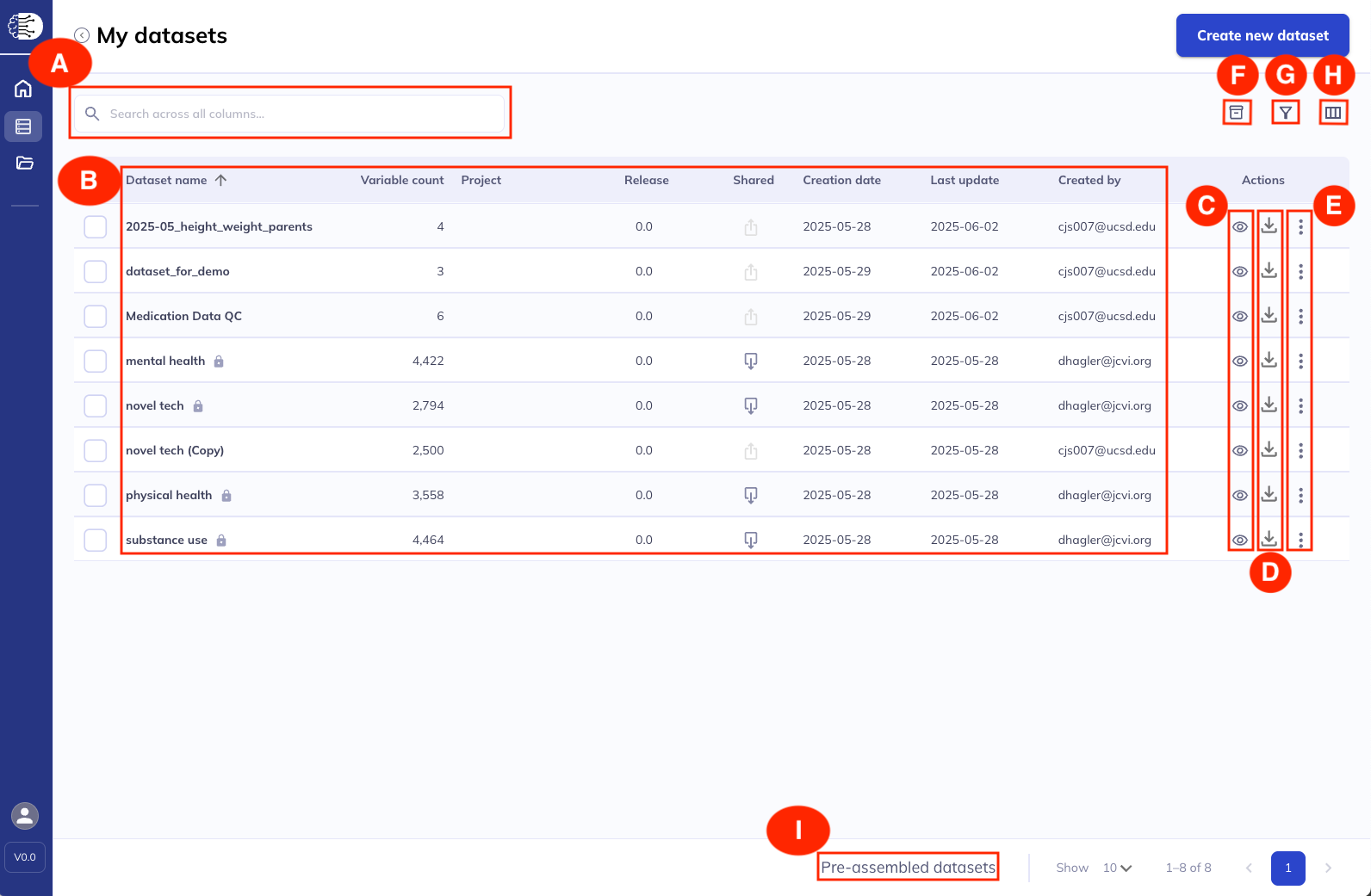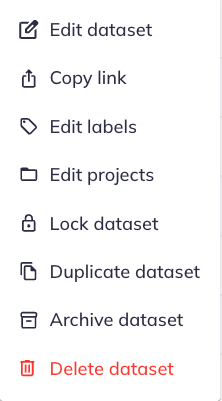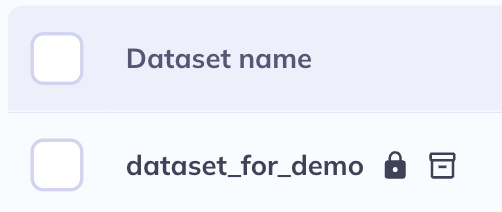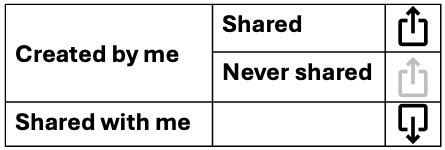My datasets
The My Datasets tab in DEAP serves as your central hub for managing and accessing your datasets. In this tab you get a summary view with key details about the datasets that exist on your DEAP profile. Within My Datasets you are able to organize your datasets, share datasets with others, download your datasets, and further explore your data.
A. Search: Explore your datasets by any column displayed in the table.
B. Datasets details:
- Dataset name is the name provided by the original creator of the dataset. If you are the dataset author the dataset name can be edited through the same dialog that you would edit the dataset contents. Dataset names cannot be duplicated.
- Variable count displays the total current count of variables in a dataset including those added via the additional variables dialog.
- Project is a user applied file organization system for datasets. Learn more about My projects here.
- Release indicates the release the data originated from (e.g. 6.0 data release).
- Shared uses the icon to indicate if a variable was shared with your as well as if you have ever shared the dataset.
- Creation date is the date the dataset was originally set up, regardless of how many changes have been made to the dataset.
- Last update displays the last time anything was done to the dataset. This includes changes to the variables set (adding, deleting variables) and organizational changes (renaming, adding to a project, editing labels, etc).
- Created by helps you identify datasets you created and who shared datasets with you.
C. View datasets: Explore your dataset by clicking the icon. This view allows you to see all existing variables, edit dataset names, labels, and projects. You can also search your dataset & see the variable details. Learn more here.
D. Download dataset: To download your dataset click . This will launch a dialog box where you can modify download settings, prepare datasets for download, download the data, and access meta-data files. Learn more in the download section below.
E. Additional actions: The additional actions icon () offers further actions including editing a dataset, sharing the link to a dataset, defining labels & projects, duplicating datasets, and archiving/locking/deleting datasets.
F. Archived datasets: This button () allows you to display or hide, within the main table view, datasets that you have archived. To learn more about how and why to archive datasets please review below.
G. Filter dataset view: Similar to how you can with variables in a dataset you can also filter your displayed datasets. Like with variables, the filter function only works on columns that are currently displayed in the table (see item H).
H. Edit table view: You have the flexibility to remove and add meta-data columns to your view of the My Datasets table. For example, if you aren’t interested in the creation or update dates you can remove those columns giving more space to the information you want to visually prioritize.
Like with the data dictionary table you can edit the layout of the table.
Rearrange columns by clicking and dragging the column header around. Click between columns and drag () to change the width of columns. Click () in the column header for additional options such as sorting ascending/descending, pinning a column, filtering a column, or hiding the column. You can also select (/ ) to sort alphanumerically ascending/descending.
I. Pre-assembled datasets: Because the DEAP platform limits custom datasets to 10,000 variables and since many users may have a similar set of variables they want some pre-assembled datasets are available for expedited download. Learn more about pre-assembled datasets below.
Duplicate
To create a copy of a dataset click additional actions () in My Datasets and then select ‘ Duplicate dataset’. This will create a copy of the dataset as it exists now, it will get a new creation date, and will exist independently of the source dataset; meaning any update to either dataset will not impact the other.
Delete, archive, lock
Datasets can be managed in various ways to suit different stages of the research data-cycle. Deleting, archiving, and locking databases can be completed from the additional actions () menu. Projects cannot be locked or archived but they can be deleted. The status of datasets, with regards to locking and archiving, is indicated next to the Dataset name.
Deleting ( ) a dataset will remove it from your DEAP profile permanently. Deleted datasets cannot be retrieved. Deleting a dataset is ideal for datasets that were never used, contain mistakes, or were replaced with new working datasets.
It is not advisable to delete datasets that have ever been used for publication, presentation, or public purposes as the history of the dataset will not be available and may not be able to be re-created. Instead we recommend locking and archiving datasets utilized for research claims.
Archiving () a dataset is a way to remove it from the primary view of My Datasets without deleting it, reducing clutter but retaining data. Archived datasets can be unarchived, locked, edited, and organized; the same as non-archived datasets. Datasets that are no longer of active use but that have historical use and value are good use cases for archiving. To toggle archived datasets in and out of view in My Datasets click the icon in the top right.
Locking () a dataset prevents it from having any changes occur, preserving a historical record overtime. Locking a dataset is useful for reproducible research and data transparency. Locking a dataset guarantees the exact version of data you used in an analysis is fixed at the point of time you created the dataset. Locked datasets can still be shared, archived, duplicated, and downloaded. They can also be organized with changes to the labels and adding them to new projects. Locked datasets cannot have any variables added or removed and they cannot be renamed. A dataset that is locked because it was shared with you will have a grey icon () as opposed to a black one () which indicates you locked the dataset.






